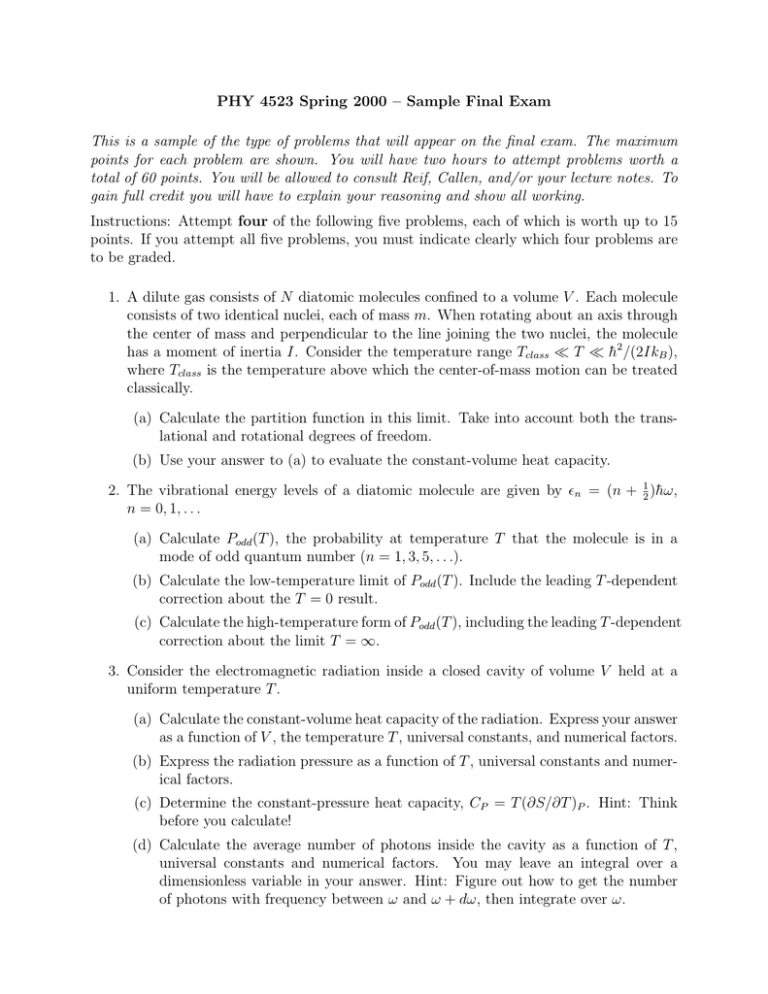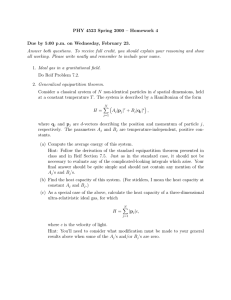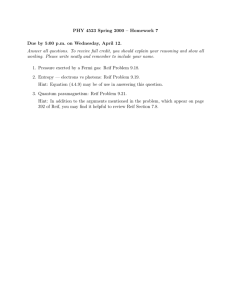PHY 4523 Spring 2000 – Sample Final Exam
advertisement

PHY 4523 Spring 2000 – Sample Final Exam This is a sample of the type of problems that will appear on the final exam. The maximum points for each problem are shown. You will have two hours to attempt problems worth a total of 60 points. You will be allowed to consult Reif, Callen, and/or your lecture notes. To gain full credit you will have to explain your reasoning and show all working. Instructions: Attempt four of the following five problems, each of which is worth up to 15 points. If you attempt all five problems, you must indicate clearly which four problems are to be graded. 1. A dilute gas consists of N diatomic molecules confined to a volume V . Each molecule consists of two identical nuclei, each of mass m. When rotating about an axis through the center of mass and perpendicular to the line joining the two nuclei, the molecule has a moment of inertia I. Consider the temperature range Tclass T h̄2 /(2IkB ), where Tclass is the temperature above which the center-of-mass motion can be treated classically. (a) Calculate the partition function in this limit. Take into account both the translational and rotational degrees of freedom. (b) Use your answer to (a) to evaluate the constant-volume heat capacity. 2. The vibrational energy levels of a diatomic molecule are given by n = (n + 12 )h̄ω, n = 0, 1, . . . (a) Calculate Podd (T ), the probability at temperature T that the molecule is in a mode of odd quantum number (n = 1, 3, 5, . . .). (b) Calculate the low-temperature limit of Podd (T ). Include the leading T -dependent correction about the T = 0 result. (c) Calculate the high-temperature form of Podd (T ), including the leading T -dependent correction about the limit T = ∞. 3. Consider the electromagnetic radiation inside a closed cavity of volume V held at a uniform temperature T . (a) Calculate the constant-volume heat capacity of the radiation. Express your answer as a function of V , the temperature T , universal constants, and numerical factors. (b) Express the radiation pressure as a function of T , universal constants and numerical factors. (c) Determine the constant-pressure heat capacity, CP = T (∂S/∂T )P . Hint: Think before you calculate! (d) Calculate the average number of photons inside the cavity as a function of T , universal constants and numerical factors. You may leave an integral over a dimensionless variable in your answer. Hint: Figure out how to get the number of photons with frequency between ω and ω + dω, then integrate over ω. 4. Consider an ultra-relativistic gas of N noninteracting electrons in a cubic box of sides L and volume V = L3 . Just as in the nonrelativistic case, the single-particle states have wavevectors of the form k= 2π (nx , ny , nz ), L where nx , ny , and nz are integers. However, in the ultra-relativistic limit, the energy of each state can be approximated by (k) = h̄c|k|, where c is the velocity of light. (a) Calculate the Fermi energy F . (b) Calculate the constant-volume heat capacity in the limit of high temperatures T F /kB , where the Fermi-Dirac distribution can be approximated by the Maxwell-Boltzmann distribution. Express your result as a function of N , kB , and numerical constants. Hint: Evaluate Reif Eqs. (9.17.1) and (9.17.2) with F () and ρ() suitably modified to describe the problem at hand. You may find Reif Eq. (A.3.3) useful in evaluating the integrals. 5. The velocity of sound waves in liquid 4 He at temperatures below 0.6 K is 238 m/s. The sound waves are longitudinal—there are no transverse modes. The density of liquid 4 He is 145 kg/m3 and the mass of one 4 He atom is 6.7 × 10−27 kg. (a) Calculate the Debye temperature for liquid 4 He. (b) Calculate the constant-volume specific heat capacity of liquid 4 He at 0.3 K (in units of J kg−1 K−1 ).






